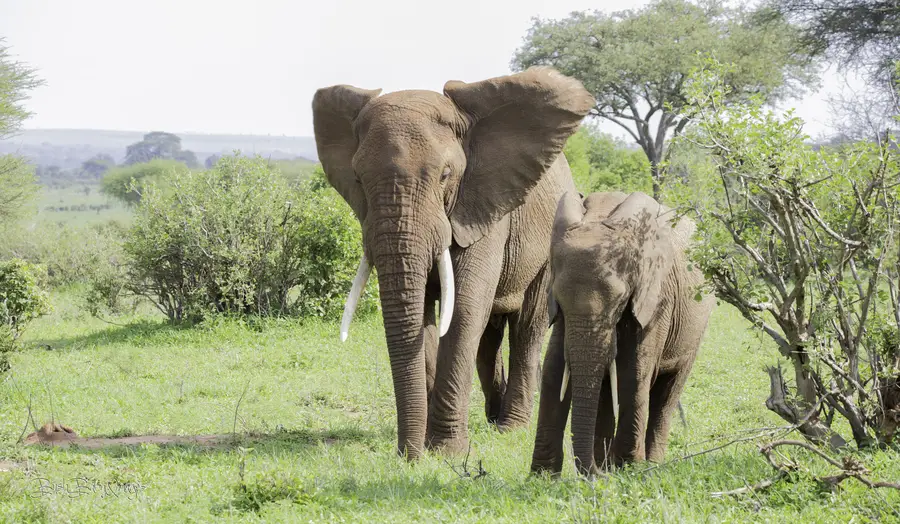Engaging New Partners in Tanzania Provides Best Practices for Localization

Jennifer Cupp
Communications Consultant

“STEP was very small when we started in late 2014. We were basically five people and a Land Rover,” said Trevor Jones, the CEO and co-founder of the Southern Tanzania Elephant Program (known as STEP). “Today, we’re 30 people and five Land Rovers.”
STEP is a local nonprofit organization focused on elephant conservation in Tanzania and was a critical partner to the success of the USAID Promoting Tanzania’s Environment, Conservation and Tourism (USAID PROTECT) project, implemented by RTI International.
USAID PROTECT took the time to mentor Jones and his organization and help them build the capacity to connect with, and influence, the national government’s priorities for conservation and to access new funding sources. One of these priorities is restoring wildlife corridors, including elephant corridors in the Kilombero Valley such as the Mwanihana-Magombera Corridor (Kilombero Elephant Corridor).
While the project focused initially on engaging private sector partners in the tourism sector, the team quickly realized that engaging local organizations from the very beginning – even those outside of tourism areas like STEP – was going to also be critical for success, said Kathy Wachala, director of the environment portfolio for RTI’s International Development Group.
USAID PROTECT took a proactive approach to tapping into new partners, engaging them as a full partner from the outset and building their capacity beyond the life of each award.
In the past, this might not have been possible. All too often, the administrative load and requirements – and restrictions – for funding keep promising local organizations from working with donors like USAID. When STEP first applied for a grant from USAID PROTECT in 2018, it didn’t qualify.
“When you go through a process like a technical evaluation committee or reviewing grants, there are a lot of boxes to check,” said Wachala. “If you only narrowly focus on the boxes to check, you’re going to miss out on a lot of good potential. And STEP was one of those organizations – they didn’t hit all the boxes but had a lot of potential.”
Like many small organizations, STEP was primarily focused on technical work and not operations. Yet it had a fundamental conservation focus, solid technical experts and valuable data that could inform policy making. It also had a history of deep engagement with the communities around the elephant corridor.
“The USAID PROTECT team saw a lot of real solutions that could come from [STEP’s strengths] to expand conservation efforts in Tanzania,” Wachala said. She recently reflected on this at a USAID-hosted learning event on localization.
“We first looked at ourselves and how we, as a project team, could meet organizations like STEP where they were. We talked about how we [could] build more support for organizations like STEP to build up their operational, financial and information technology and communications systems”.
“We had an opportunity to sit with them and work with them to better shape their grant application,” said Thadeus Binamungu, Chief of Party for the RTI-led USAID Tuhifadhi Maliasili Activity (“Preserve Natural Resources” in Swahili) and former Chief of Party for USAID PROTECT. “We worked with them to review their budget and work plans so that way it wasn’t just helping them get funding from USAID PROTECT but also building their capacity in writing proposals for future funding.”
Once STEP qualified and became a grantee, the project’s technical team and STEP held weekly discussions; jointly planned and participated in activities and meetings with other stakeholders, like the Tanzanian government; took part in regular site visits; and prepared and reviewed project documents and deliverables together.
“It’s been really special… it’s been very different from the outset,” Jones said. “They really knew the environment and the challenges. It was a different type of donor-grantee relationship, being able to talk with the USAID PROTECT team and feel like they really understand our challenges on the ground. And they were very flexible with our challenges as a result.”
It has been well established that local organizations are best positioned to drive their country’s development. Yet, their voices have largely been left out from the design and implementation of development programs that affect their communities.
The approach USAID PROTECT took offers localization lessons for other development projects and practitioners.
“The success we are all proud of about USAID PROTECT hinges on one big thing – listening and responding to priorities,” Binamungu said. “We had it as a practice to listen and respond to the priorities of the government. That way, when we were going to approach new partners like STEP, we already knew what the priorities were so we could then capitalize on the knowledge and experience of partners like STEP to address them.”
The USAID PROTECT team communicated clear expectations and worked with STEP to build its capacity, expand its potential, and navigate USAID requirements. They maintained a constant flow of information and input between the technical, grants, and monitoring and evaluation teams for optimal support. USAID PROTECT also made introductions and provided advice that helped STEP connect its strengths, such as data and community outreach, with the policy process in the country.
Taking a mentorship approach, or in Wachala’s words a “stepping stone philosophy,” was also key to building a successful partnership. “We were not in the business of asking STEP to build a whole new staff for the sake of getting one grant from us,” she said. “But we were looking at it as ‘how do we put something in place that’s effective for them to get a grant from us but can also help them in the long run?’”
The project held a participatory organizational capacity assessment with STEP at the start of the grant award, where STEP identified its own challenges, priorities, and areas for mentorship. In-person visits from USAID PROTECT staff throughout the award built strong interpersonal relationships and enabled STEP to identify any new challenges or priorities for which it wanted further mentoring.
“They fostered local ownership,” said Joseph Mwalugelo, the corridor restoration manager for STEP. “We knew it was a USAID [project], but the way they operated was like a local organization.”
“Regular visits provided more room for discussions and helped us see things on the ground,” Binamungu said. Technical and operational experts on the USAID PROTECT team provided mentoring on grant management, compliance, monitoring and evaluation, financial management systems, and more.
In addition, USAID PROTECT kept long-term strategy at the forefront of their discussions and planning with STEP. “We were incredibly deliberate to be clear on…what is the grant going to do now and what does it look like when you don’t have a grant,” Wachala said. We talked with STEP about how to use this grant as a stepping stone for future funding and improvements.
As a result of mentoring, STEP upgraded their financial systems, expanded their programming into conservation education in schools, and developed new partnerships and relationships to expand conservation work.
The USAID PROTECT project ended in 2020. Nearly two years later, STEP continues to grow and the Kilombero corridor restoration is on track. STEP now plays an expanded partner role as a subcontractor on a new USAID conservation project, which builds on the success of USAID PROTECT. STEP has also secured $180,000 (USD) from international donors for restoration of the Kilombero Elephant Corridor since 2018. And it has unlocked private sector funding for the corridor – an option that USAID PROTECT influenced STEP to consider and implement.
“The [USAID PROTECT] technical experts were really involved, and they helped push our thinking. For example, they introduced us to public-private partnerships. It got us thinking outside the box,” Mwalugelo noted.
The trust, open communication and adaptive management approach built between PROTECT and STEP also helped when COVID-19 hit.
“Initially, we were scared that many things would fall apart,” Binamungu said. “But because of that transparency, collaboration, and communication we were able to continue.”
Jones noted the corridor project can now be a new blueprint for other corridors in Tanzania, a sentiment that was reflected by Tanzania’s director of wildlife during a site visit.
“It shows people new possibilities – that we can all work together,” Jones said.
Indeed, working together has meant success for this project; from the donor-implementer-grantee relationship to STEP’s relationship with the Tanzanian government and the communities it serves.
STEP is now regarded in Tanzania as a “go to” conservation organization. The government asked Jones to lead development of Tanzania’s first national human-wildlife conflict strategy and STEP staff were involved in writing it.
For Wachala, it all comes down to curiosity, creativity, and respect on the part of implementers. Working with new partners often involves risk, but she encouraged development practitioners to approach that with curiosity rather than hesitation.
“Be curious on how you are approaching this work with the fact that you’re not there forever – they are,” she said. “You can come in with ‘let me try to walk in your shoes and understand where you’re coming from.’ That’s a huge piece of the puzzle that sometimes we don’t give time for.”
In this case, the risk was worth the reward. “Making them USAID ready makes them ready for other funders too,” Wachala said. “It opens new doors.”
“Localization makes sense,” she added. “There is some groundwork to do at the beginning, but if you do it at the front end, you will reap the benefits.”
Learn more about RTI’s work in Tanzania.